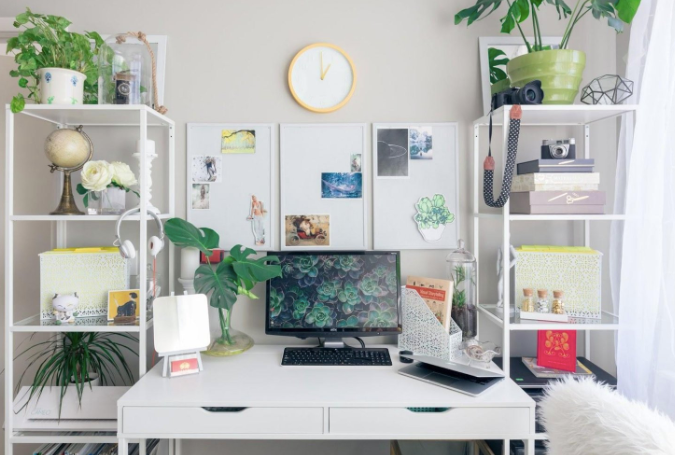An organized office desk is more than just an aesthetically pleasing sight; it’s a foundation for productivity and efficiency. A clutter-free workspace can help reduce stress, improve focus, and enhance your overall work experience.
Whether you’re working from home or in a traditional office setting, here are some practical steps to help you organize your office desk and create a conducive environment for getting things done.
1. Declutter your desk
The first step in organizing your office desk is decluttering. Start by removing everything from your desk and placing it on a nearby table or the floor. This blank canvas will allow you to assess each item and decide whether it truly belongs on your desk.
Sort items into three categories:
- Essential: These are items you use frequently and need at arm’s reach.
- Secondary: These items are useful but not essential for daily work.
- Unnecessary: These are items that rarely or never get used on your desk.
Now, return the essential items to your desk and store secondary items in desk drawers or nearby organizers. As for unnecessary items, consider whether you can find a more suitable place for them or if they can be removed from your workspace entirely.
2. Invest in proper storage solutions
To maintain an organized desk, you’ll need appropriate storage solutions. Here are a few options to consider:
- Desk drawers: If your desk has drawers, use them to store frequently used items like pens, notebooks, and office supplies. Consider using drawer dividers to keep smaller items organized.
- Shelves: Wall shelves or desktop shelves can be used to store books, binders, and reference materials. They keep important resources accessible without cluttering your work surface.
- Desk organizers: Desk organizers, such as file holders, letter trays, and pencil cups, are perfect for keeping frequently used items within arm’s reach. They come in various styles and sizes to suit your needs.
- Filing cabinets: If your work involves a lot of paperwork, investing in a filing cabinet can help you keep important documents organized and easily accessible.
3. Establish a routine
Maintaining an organized desk isn’t a one-time task; it’s an ongoing process. Establish a routine for keeping your workspace tidy. This could include a daily or weekly desk declutter session where you sort through papers, discard unnecessary items, and ensure everything has its designated place.
4. Cable management
Cable clutter can quickly make your desk look disorganized. Use cable clips, cable sleeves, or cable boxes to keep your cords and cables neat and untangled. This not only improves the appearance of your desk but also prevents accidental unplugging and makes it easier to clean.
5. Label everything
Labeling is a simple yet effective organization technique. Use labels on drawers, containers, and files to make it clear where everything belongs. This not only helps you find what you need quickly but also reminds you to put things back in their proper place.
6. Use vertical space
If your desk space is limited, make use of vertical storage. Wall-mounted shelves, pegboards, or corkboards can hold documents, notes, and frequently used items, keeping them within reach without cluttering your desk.
7. Digital organization
Don’t forget about digital organization. Keep your computer desktop clutter-free by organizing files into folders. Regularly delete files you no longer need and empty your trash bin. Utilize software tools like digital note-taking apps and task managers to keep your virtual workspace organized.
8. Prioritize what’s important
Keep the most important items within easy reach. This might include a notepad for jotting down quick notes, your favorite pen, or a family photo that brings you joy. Having these items close at hand can improve your mood and productivity.
9. Personalize your workspace
While it’s important to keep your desk organized, don’t forget to personalize it. Adding a plant, artwork, or personal photos can make your workspace more inviting. A touch of personalization can help reduce stress and make your office feel like a comfortable, creative space.
10. Regular cleaning
Dust and dirt can accumulate on your desk over time, so make cleaning a part of your organization routine. Wipe down your desk’s surface, keyboard, and monitor regularly to maintain a clean and organized appearance.
11. Eliminate distractions
If possible, position your desk so that it faces a wall or a less distracting area. This can help you stay focused and reduce the temptation to look around or get distracted by outside elements.
12. Minimize office supplies
Keep only the office supplies you regularly use on your desk. Extra pens, sticky notes, and other supplies can be stored in drawers or nearby organizers to reduce clutter.
13. Digital distraction control
In addition to physical organization, control digital distractions by using website blockers or apps that limit your access to social media or other time-wasting websites during work hours.
14. Evaluate desk accessories
Consider the accessories on your desk. Do they serve a functional purpose, or are they primarily decorative? While some decor is great, make sure it doesn’t impede your workspace’s functionality.
15. Mindful paper management
Handle incoming papers mindfully. Sort through your mail and documents regularly, recycling or filing them immediately to prevent paper piles from forming.
Conclusion
Organizing your office desk is an ongoing process that can greatly enhance your productivity and overall work experience. A clutter-free workspace reduces stress and helps you focus on your work in a better way and deliver improved results.

Leave a Reply